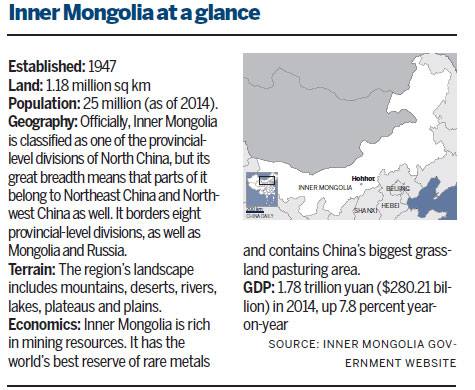Editor's note: Despite China's economic slowdown, the Inner Mongolia autonomous region recorded better-than-average economic growth over the last two years thanks to the opportunities provided by the Belt and Road Initiative. The region is becoming more open to the world, especially to Russia and Mongolia in the north. China Daily spoke recently to Wang Jun, Inner Mongolia's Party chief, to find out more.
The Inner Mongolia autonomous region has realized stable economic growth despite the general economic slowdown over the past two years. How did the region achieve this result?
Wang: The new economic situation requires new policies to cope. Inner Mongolia is traditionally a region based on the energy industry. Thus, we have been making efforts to adjust the industrial structure to ensure stable growth when commodities prices are falling. At the same time, the local government has put a focus on improving efficiency and quality, and enhancing reform.
For the first half of the year, the region's GDP growth was 7 percent. The region's fixed investment grew by 14.4 percent compared to the same period last year. The income of urban and rural residents increased by 7.7 percent and 8.3 percent year-on-year, respectively.
Those performance indicators are better than neighboring provinces and autonomous regions, a credit to policies the authority has maintained.

Besides the energy industry, in which sectors has Inner Mongolia made progress?
Wang: In recent years, the high-tech industry, livestock product processing and equipment manufacturing sectors all achieved higher than average growth in the region.
Meanwhile, the tourist industry, logistics and financial information sectors are developing rapidly.
In the past, Inner Mongolia's major economic growth contributor was the coal industry and the others lagged behind. However, the structure is quickly shifting to a more healthy and reasonable one.
What are the key sectors to be developed in the future?
Wang: We will build Inner Mongolia into a major clean energy provider to other places in the country by developing the coal chemical industry. Meanwhile, we will develop nonferrous metal processing, equipment manufacturing, livestock product processing and cultural tourist industries aimed at improving our economic structure.
After 60 years of development, Inner Mongolia has had much experience in those sectors, and we have confidence that the region can make a bigger contribution by accelerating the development of those industries. For instance, clean energy will help the country to reduce carbon emissions. Livestock product processing and tourism will meet the growing demand from consumers and improve living standards.
By developing those industries, there will be more jobs in the region, which will greatly increase the income of our residents.
